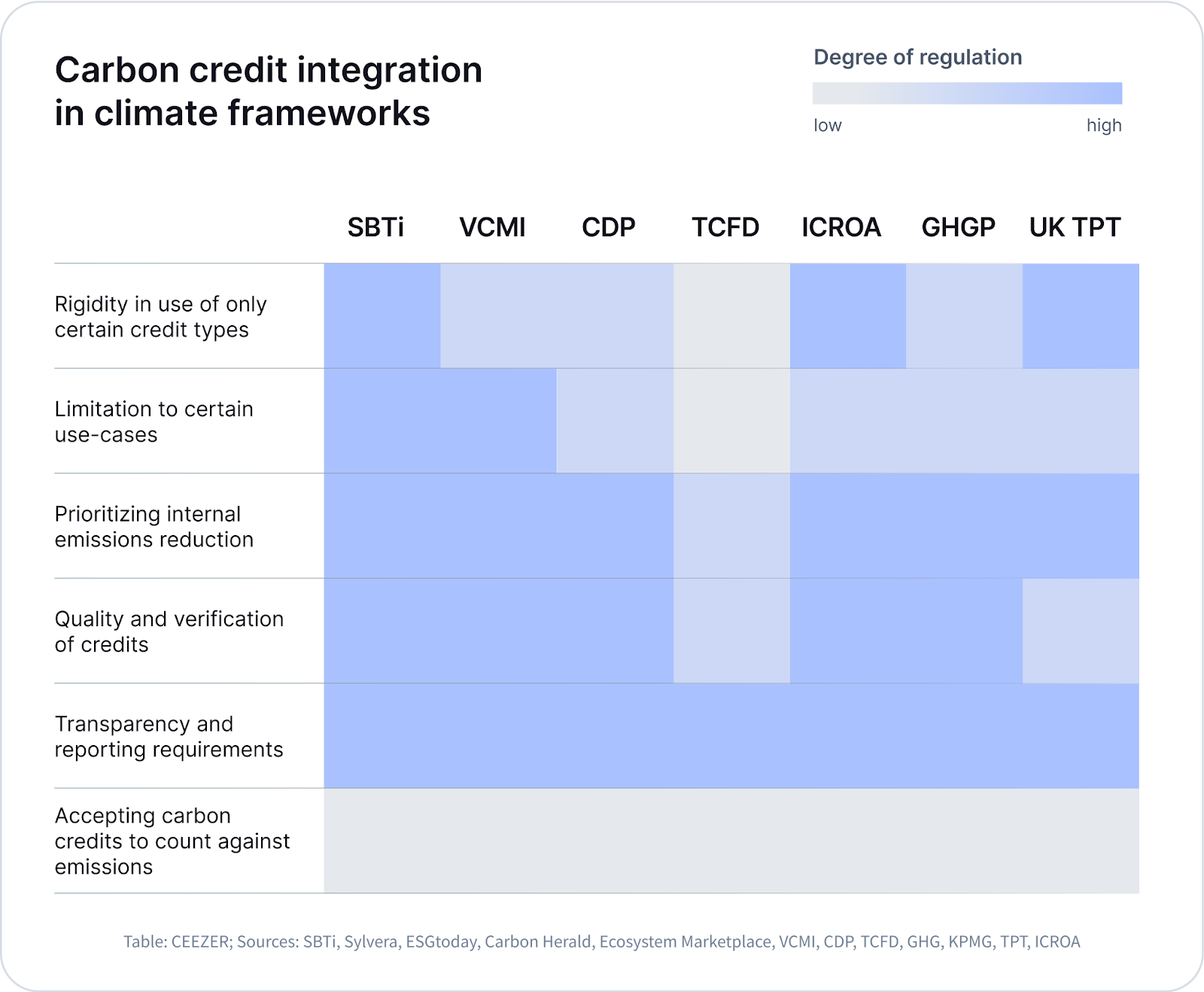Approaching net-zero is daunting. Internal reduction goals, a myriad of applicable regulatory and non-regulatory frameworks, and often steep targets. Enterprises on their path to net-zero need concise, fact-driven transition plans to execute their climate vision. More and more, carbon credits are becoming a need to accelerate or bridge gaps in case of target deviations. Their role within transition plans, however, is far from clear. With leading frameworks delaying clear guidance on the legitimate use of carbon credits in net-zero journeys, decisions around investment in carbon markets are increasingly complex. This article outlines where we stand - and gives an overview of current best practices for an impactful integration of carbon credits in transition plans.
Decarbonize now: Every day counts
Corporate net-zero goals and timelines might differ wildly, but the global race to decarbonize is far less flexible.
In line with the Intergovernmental Panel on Climate Change (IPCC), both the Carbon Disclosure Project (CDP) and Transition Task Force (TPT) stress the importance of two time-bound targets to create a sustainable economy: halving emissions by 2030 and reaching net-zero by 2050. To meet these environmental deadlines, enterprises must prioritize decarbonization now. To get there sustainably and strategically, corporations need to develop transition plans. More often than not, transition plans need to complement internal emissions reductions with long-term carbon removal for residual emissions at net-zero. While the target years seem far away, decisions on securing carbon removal must be made today.
Developing actionable transition plans to drive results
Corporate transition plans align a company’s business model with its climate goals, enabling a holistic approach to decarbonization and ensuring all aspects of the business contribute to net-zero targets in a structured, accountable way. As both the CDP and TPT stress the importance of establishing time-bound targets, plans should include near- and long-term targets aligned with a 1.5°C pathway, which are tracked using KPIs. This includes value chain engagement, increasing the revenue share from low-carbon products or services, and implementing emissions reduction initiatives for both direct and indirect operations.
The role of carbon credits in transition plans is currently unclear for most frameworks. Although they are never explicitly required by many frameworks, they almost always play a strategic role in securing a net-zero future after maximum internal reductions have been accomplished. While removal credits (actively removing CO₂ or other GHG emissions from the atmosphere) are widely recognized as a crucial tool, their acceptance along the journey varies across leading climate frameworks.
A well-rounded integration of carbon credit use in transition plans can ensure that their use is impactful and fit for purpose as a supplementary measure. These plans can help organizations meet immediate climate targets, manage risks, maintain credibility, and track progress toward long-term climate goals.
Compensate for impact: The current role of carbon credits in transition plans
What we know: Currently accepted use cases for carbon credits in transition plans
While carbon credits are not central to current guidance frameworks, they already serve as important components of robust climate strategies in practice.
Removal for residual emissions neutralization after net-zero: While exact guidelines are still to be laid out, companies must use permanent removal carbon credits to neutralize (SBTi and Race to Zero) or counterbalance (ISO) emissions that cannot be abated further. This is done after all abatement measures have been taken to achieve and maintain a state of net-zero. Furthermore, residual emissions at net-zero cannot generally exceed the range of 5 – 10 % compared to baseline emissions.
Beyond value chain mitigation (BVCM): BVCM, as stated by the SBTi, involves incorporating both avoidance and removal credits to address emissions beyond a company's value chain. Companies should consider how different scenarios require different credit types, aligning with the Oxford Principles.
While durable removal credits should ultimately be the preferred option, incorporating a mix of removal and avoidance credits can help address budget constraints. This way, companies can build a diversified portfolio to position themselves for future regulatory changes, secure supply and volumes, gain critical market insight, and align with framework recommendations.
Today, however, the primary focus of transition frameworks is guiding internal emission reductions, meaning carbon credit use is either rarely defined or presented as an optional, complementary measure. The following heatmap illustrates how carbon credit integration is currently referenced in certain climate frameworks.

The consequence of lacking guidance: Survey data suggests buyer hesitation to expand VCM involvement due to limited carbon credit recognition by climate frameworks
In a 2024 survey by ‘We Mean Business Coalition’, 61% of corporate leaders currently purchasing credits stated their primary reason for limiting VCM engagement is a lack of recognition by climate goal standards. This could significantly delay climate impact and companies’ ability to leverage carbon credits while the right credits could potentially accelerate this impact today.
This challenge highlights the need for more comprehensive guidance to ensure carbon credits are effectively integrated into transition plans, with substantial evidence supporting the importance of this shift. Some surveys indicate a correlation between VCM engagement and year-on-year decarbonization. This suggests companies properly leveraging carbon credits alongside internal reduction efforts to meet scope 1, 2, and 3 goals are addressing their net-zero targets more effectively than those focusing on emissions reductions alone.
Strategic scenarios: When to leverage carbon credits in transition plans beyond existing framework guidance
Beyond the currently accepted use cases, carbon credits are increasingly used to maintain transition momentum for specific challenges, such as scope 3 and hard-to-abate emissions. The following two scenarios, however, are not (yet) a recommendation under the frameworks mentioned in the heatmap above.
Scope 3 emissions: Decarbonizing scope 3 emissions, which often make up for up to 90% of a company’s total emissions, is challenging due to limited control over value chain activities. Few companies have made significant progress here. While data shows an increase in the establishment of scope 3 reduction targets, companies are falling short, with over one-third lagging behind their upstream scope 3 targets. The VCMI is currently undergoing stakeholder consultations and the SBTI is in the process of revising their net-zero standard to address this issue.
If not addressed soon, this gap could severely widen to over 7 GtCO2e by 2030. Removal credits can provide a short-term bridging solution, allowing companies to compensate for scope 3 emissions today while establishing long-term reductions. Frameworks like the Integrity Council for the Voluntary Carbon Market (ICVCM) acknowledge the role of high-quality removal credits and are evolving to ensure the responsible, strategic use of removal credits to address scope 3 emissions.
Hard-to-abate emissions: Industries such as aviation, steel, and construction often struggle to reduce emissions due to technological, operational, and financial constraints.
For instance, the aviation industry faces challenges in switching to sustainable aviation fuel, which remains expensive and limited, while upgrading to more efficient aircraft fleets demands substantial investment. Similarly, the steel industry’s reliance on coal-fueled blast furnaces means transitioning to electric arc furnaces is both technologically demanding and requires significant capital. In the construction sector, heavy dependence on concrete presents a challenge, as emissions related to cement production stem from chemical processes that are difficult to change.
These sectors are inherently emission-intensive and have limited access to low-carbon alternatives, making emissions abatement costly and complex. Here, matching emissions with permanent, net-zero-compliant removals in near real-time ensures effective and timely decarbonization efforts which help bridge the abatement process. As part of this effort, supporting the development of the most efficient and effective climate mitigation projects, market-driven price competition is especially crucial. It encourages innovation and ensures best possible solutions emerge, and ultimately become widely accessible.
It’s important to keep in mind that excessive reliance on carbon credits without corresponding internal efforts can undermine and limit climate impact. Also, using carbon credits for use cases outside of current frameworks will not be recognized against targets until guidance has been updated. Therefore, developing a well-rounded, transparent transition plan that incorporates carbon credits as a supportive, but not substitutive, measure can help companies reach net-zero, especially those at major risk of falling short of reduction targets.
Leveraging carbon credits: Best practices for long-term impact
Having discussed how to leverage carbon credits in transition plans, here are a few best practices on how to maximize impact:
- Prioritize internal scope 1 & 2 decarbonization accompanied by neutralization of residual emissions: The primary goal should be decarbonizing internally as quickly as possible. This means engaging well before the net-zero target year and reducing scope 1 & 2 emissions by at least 95%, according to SBTi guidelines. This process can be complex and lengthy, particularly in industries like aviation and construction, and addressing remaining residual emissions early through the VCM should be an integral part of transition plans. Utilizing high-permanence removal credits, such as direct air capture or biochar, for residual direct emissions can ensure lasting impact and signal a strong commitment to long-term environmental responsibility, aligned with SBTi principles.
- Incentivize integrated supply chain decarbonization for scope 3: Engaging and incentivizing your supply chain is critical for achieving meaningful scope 3 emissions reductions. While internal efforts should be prioritized, reductions are becoming increasingly difficult to achieve further down the supply chain.
Companies can adopt a collaborative, tiered approach by establishing a qualitative carbon credit portfolio, designed and maintained by the driving company to set a clear standard for suppliers (comparable to setting standards for joint scope 3 efforts along the supply chain). This portfolio can be made accessible to the rest of the supply chain, encouraging them to actively contribute to and invest in climate impact aligned with the driving company's goals. This ensures quality standards are adhered to throughout the supply chain. By using carbon credits to address and compensate for emissions that are difficult to control directly, companies foster a shared responsibility across the supply chain and can accelerate overall decarbonization efforts.
- Secure long-term carbon credit agreements: Companies should establish long-term agreements to guarantee future supply to mitigate market risks and ensure alignment with internal reductions, future decarbonization goals, and regulatory shifts. Companies should also consider how the regulatory landscape, and corresponding incentives, continue to evolve. For example, Singapore’s carbon tax, which allows up to 5% eligibility for carbon credits, and encouragement from the U.S. Department of Energy for voluntary carbon credit purchases demonstrates how regulators shape the market. Understanding and anticipating regulatory developments, and securing long-term carbon credit supply accordingly, can help companies align with evolving requirements. This helps maintain integrity and credibility in reducing claims and allows companies to leverage incentives supporting their transition plans.
- Track, measure, and report regularly: It is essential to monitor portfolio performance and maintain transparent reporting to ensure ongoing credibility and impact. Companies can then work towards being radically transparent, going beyond minimal reporting to provide clear, comprehensive data around carbon credit use and net-zero progress. Getting ahead here will serve companies in the long term as disclosure frameworks like the ICVCM, CSRD, and CDP double down on transparency. By proactively aligning with these frameworks and regularly assessing and disclosing progress, companies can adjust their strategy, strengthen stakeholder trust, and demonstrate net-zero commitment.
Strengthening transition plans with carbon credits
Achieving net-zero requires an effective, strategic, and balanced approach that aligns immediate actions with long-term strategies. Companies need transition plans that enable continuous monitoring, adaptation, and stakeholder engagement to keep up with evolving climate goals. Making these transitions publicly transparent can further demonstrate commitment to bold environmental action to both customers and the broader global community.
When strategically integrated, carbon credits can help businesses bridge the gap between emissions targets and actual reductions, especially in challenging areas such as scope 3 and hard-to-abate sectors. While the formal inclusion in most frameworks is pending, decisions are being made today.
By prioritizing decarbonization efforts now, companies can strengthen progress toward net-zero and the impact of their transition plans. Alongside feasible internal decarbonization efforts, carbon credits are already integrated as part of a broader, proactive strategy rather than as an afterthought. Taking action now sets a strong foundation, allowing companies to profit from tangible benefits such as secured removal supply, better pricing, and lower target risk for net-zero and beyond. Starting to invest in removal also facilitates a strong positioning as corporate sustainability leaders.
Learn more about CEEZER and our future-proof carbon portfolios by booking a demo here.





